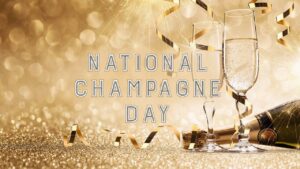National Champagne Day
By Sharon Schweitzer
Champagne is more than just a drink; it’s a symbol of life’s victories, milestones, and the promise of new beginnings.
National Champagne Day, observed annually on December 31st, is a delightful occasion dedicated to the world-renowned sparkling wine known as champagne. It’s a day to indulge in the effervescent charm of champagne, savor its elegant taste, and toast to special moments in life. This date also beautifully coincides with New Year’s Eve, a night already synonymous with festivities, jubilant gatherings, and toasts to new beginnings. As the year draws to a close, National Champagne Day offers a fantastic opportunity to culminate the year’s experiences, both joyful and challenging, and raise a glass of bubbly in anticipation of the fresh adventures the new year will bring.
As was often the case due to their careful tending of vineyards, monks were responsible for the appearance of champagne into the world. In 1697, one nearly-blind monk from the Champagne region of France, Dom Pierre Perignon, is credited with discovering the process of wine fermentation as it relates to the weather (cold winter, warm spring). While it first seemed like a mistake, it turned out to be delicious. In fact, some of the champagne is still named after him to this day.
Some English folks also lay claim to the invention of this bubbly wine, stating that the process was found 35 years prior, in 1662 in the Cotswolds. This is when a scientist named Christopher Merrett wrote down his process of putting bubbles into wine by the addition of sugar.
It’s no surprise that the French are particular about what is allowed to be called champagne, as the four styles of true champagne that exist on the market are produced according to very strict standards set by the organizations in charge of such things. The four types of champagne are distinguished both by which area of the province they come from, as well as what forms of grape are used in their manufacturing process.
So what makes the difference between champagne, prosecco and all sorts of other bubbly white wines? First, the types of grapes champagne makers use typically will include varieties such as Pinot noir, Chardonnay or Pinot Meunier in their blends. A couple of others that might be used include Pinot Gris or Petit Meslie. And they are all, of course, from the Champagne region of France.
While some champagnes are sweet and others are a bit drier, they will typically have similar flavors, including hints of apple, orange zest, white cherry or almond. The aging process sometimes gives it a bit of a strange aroma that contains hints of cheese-rind, toast or brioche.
The first American champagnes were made in 1842 near Cincinnati, and used Catawba grapes. Over seventy countries have laws specifying that a sparkling wine must be from the Champagne region for it to bear the champagne name. According to European Law, only labels that can legally bear the “Champagne” name must be bottled within 100 miles of this region. Outside the Champagne region, French sparkling wine is known as Crémant. In the United States, new wines cannot bear the name, but companies in existence before 2006 can include “champagne” in their name if they include their actual origin in their name too. For example, a sparkling wine could be named “California champagne.”
In 2010, Americans drank 15.4 million cases of sparkling wine. Of these, 9.2 million were produced in the United States, 8 million of which were produced in California. Since the 1890s, the drink has also been known as “the bubbly,” and in the 1920s it was commonly referred to as “gigglewater.”
On National Champagne Day toast to your health & good fortune & welcome all the new opportunities to Celebrate Every Day.
So on this day get ready to pop a cork and open a bottle full of bubbly!
Photo by images.app.goo.gl/R1WyNEUTnXDkEGSJ9
Sharon Schweitzer JD, is a diversity and inclusion consultant, cross-cultural trainer, etiquette expert, and the founder of Access to Culture. In addition to her accreditation in intercultural management from the HOFSTEDE Centre, she is an attorney and mediator. Sharon served as a Chinese Ceremonial Dining Etiquette Specialist in the documentary series Confucius was a Foodie, on Nat Geo People. Her Amazon #1 Best Selling book in International Business, Access to Asia: Your Multicultural Business Guide, won a coveted Kirkus Star, and was named to Kirkus Reviews’ Best Books. She’s a winner of numerous awards, including the British Airways International Trade Award at the Greater Austin Business Awards.
#SharonSchweitzer, #AccesstoCulture, Access2Culture, #InternationalCelebration, #AccesstoAsia, #GlobalEtiquette, #Cross-CulturalTrainer, #InterculturalCommunication, #InternationalCommunication, #Interculturalist, #Etiquette, #CultureExpert, #Speaker, #KeynoteSpeaker, #France, #UnitedStates, #NationalChampagneDay, #GlobalChampagneDay, #ChampagneDay, #ChampagneLife, #ChampagneShowers, #PoppinBottles, #Bubbly, #Fizz, #RaiseAGlass


Leave A Comment